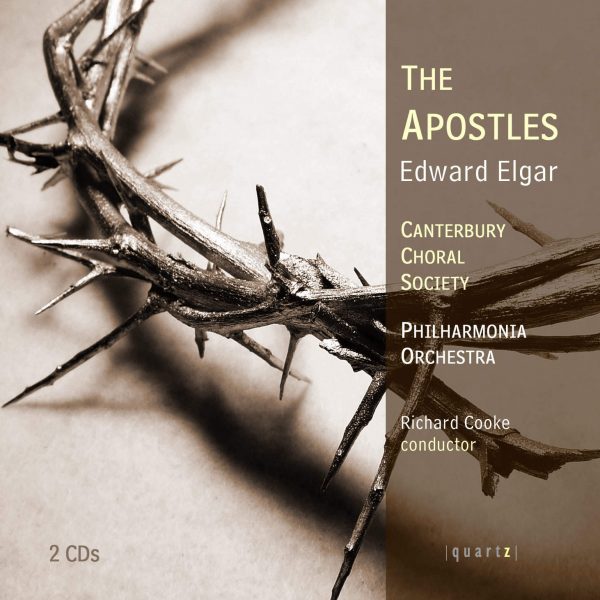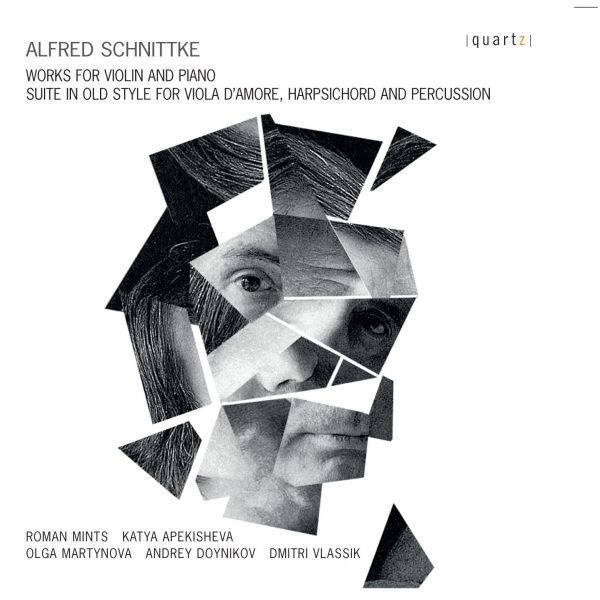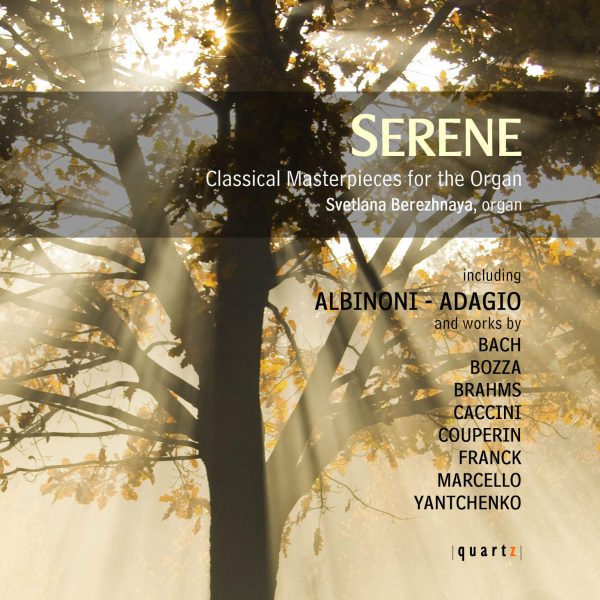J S Bach
£4.99 – £11.99
Johann Sebastian Bach (1685-1750)
Suite in A minor BWV 818a
Prélude
Allemande
Courante
Sarabande
Menuet
Gigue
Capriccio sopra la lontananza del suo fratello dilettissimo BWV 992
“Ist eine Schmeichelung der Freunde, um denselben von seiner Reise abzuhalten”
“Ist eine Vorstellung unterschiedlicher Casuum, die ihm in der
Fremde könnten vorfallen“
“Ist ein allgemeines Lamento der Freunde”
“Allhier kommen die Freunde, weil sie doch sehen, dass es anders nicht
sein kann, und nehmen Abschied“
Aria di Postiglione
Fuge all’imitazione della cornetta di postiglione
15 Sinfonia BWV 787 – 801
N° 1 in C major, BWV 787
N° 2 in C minor, BWV 788
N° 14 in B flat major, BWV 800
N° 11 in G minor, BWV 797
N° 10 in G major, BWV 796
N° 15 in B minor, BWV 801
N° 7 in E minor, BWV 793
N° 6 in E major, BWV 792
N° 12 in A major, BWV 798
N° 13 in A minor, BWV 799
N° 3 in D major, BWV 789
N° 4 in D minor, BWV 790
N° 8 in F major, BWV 794
26 N° 9 in F minor, BWV 795
27 N° 5 in E flat major, BWV 791
Prelude and Fugue in B minor (for organ, arr. Franz Liszt) BWV 544
About This Recording
How strange, how new, how beautiful were his ideas in improvising. How perfectly he realised them! All his fingers were equally skilful; all were capable of the most perfect accuracy in performance. As his obituary indicates, few could match J.S. Bach’s facility for inventing musical ideas at the keyboard, both spontaneously, and as part of the compositional process. Bach wrote music in every known keyboard form, extending the parameters of each as he did so. Bach would have played on the spectrum of keyboard instruments available in his day, including the clavichord, with its gentle sonority caused by the strings being struck, and the harpsichord, its strong sound made by plucked strings. Furthermore, Bach was known as a designer of organs, and at Cöthen he carried out repairs on all the court harpsichords. Yet the piano is now well established as an instrument with more capacity for subtlety of timbre, ideal for bringing out the nuances of Bach’s music, as on this disc. As a teacher, Bach not only demonstrated to his students the art of great keyboard skills, but also wrote for them compositions specifically designed to enhance their technique. Bach had little time for theory separate from practice; rather than writing in words how a student might excel, he chose instead to provide practical solutions. Inevitably, the results – such as the Sinfonias at the heart of this recital – are far from the dry exercises so often inflicted on students; rather, they brim with all the imagination and dexterity one would expect from such a master. It is clear that Bach’s students valued his combination of practicality and inspiration enormously. In 1790, Ernst Ludwig Gerber recorded a retrospective account of his father, Heinrich Nicolaus Gerber, as a 22-year-old student of Bach: [Bach] promised to give him the instruction he desired and asked at once whether he had industriously played fugues. At the first lesson he set his Inventions before him. When he had studied these through to Bach’s satisfaction, there followed a series of suites, then The Well-Tempered Clavier. [Christoph Wolff: ‘Johann Sebastian Bach – The Learned Musician’, p329, Oxford edition, quoting ‘The New Bach Reader: A Life of Johann Sebastian Bach in Letters and Documents’, no.315, eds Hans T David & Arthur Mendel, New York 1998 edition*] It is possible that one of this ‘series of suites’ was the Suite BWV 818, which followed what have since been called the ‘English’ and ‘French’ Suites (BWV 806-811 and 812- 817 respectively). BWV 818 was written at around the same time as the ‘French’ works – indeed, it is sometimes grouped together with those pieces – between 1722 and 1725, soon after Bach’s arrival in Leipzig. Whether or not one includes this work under the ‘French’ umbrella is somewhat academic, since Bach did not use the title himself; but the influence of French composers such as Couperin and Rameau is evident in the refined interplay between the hands, creating intricate counterpoint decorated with elaborate ornaments. Whereas BWV 818 includes a ‘Sarabande Simple’ and ‘Sarabande Double’, BWV 818a has one Sarabande, an elegant, expansive movement which exudes an almost perfumed mystery. It seems likely that the Capriccio on the departure of the Beloved Brother, in B-flat major, dates from the early 1700s, probably no later than 1704. There has been considerable speculation as to which of Bach’s friends is the dedicatee, the most plausible now thought to be Georg Erdmann, whom Bach would address as “esteemed Mr. Brother” [*Wolff p74 quoting NBR, No.121]; the occasion which prompted the work may even have been a graduation party. This touching piece opens with the “coaxing by his friends to dissuade him from his journey” and the “picturing of various calamities that might overtake him in foreign parts”, concluding with a fugue “all’ imitazione di Posta”, its countersubject imitating a posthorn – symbolic of departure. As for the ‘Inventions’ referred to by Gerber, these formed the first half of the Aufrichtige Anleitung (‘Honest guidance’), which consists of two sets of 15 contrapuntal works, each an exercise in imitative style. The two-part ‘Inventions’, with one voice for each hand, focus on voice-leading, demonstrating how a single short, clear yet freelycomposed idea – an ‘invention’ – can form the basis of a complete, coherent work. The second set, showcased on this disc, comprises three-part ‘Sinfonias’; strict, threepart compositions, with the emphasis on triadic harmonies, the title alluding to the Greek symphonia, meaning ‘sounding together’. The Inventions are the product of Bach’s years at Cöthen (1717-23), but the Sinfonias were probably not complete until early on during his time at Leipzig (from 1723). Bach prefaced the Inventions and Sinfonias with these words: Honest guidance, by which the amateurs of the keyboard – especially, however, those desirous of learning – are shown a clear way not only (1) to learn to play cleanly in two parts, but also, after further progress, (2) to handle three obligate parts correctly and well; and along with this not only to obtain good inventions (ideas) but to develop the same well; above all, however, to achieve a cantabile style in playing and at the same time acquire a strong foretaste of composition. “Aufrichtige Anleitung, womit denen Liebhabern des Claviers, besonders aber denen Lehrbegierigen, eine deutliche Arth gezeiget wird, nicht alleine (1) mit zwo Stimmen reine spielen zu lernen, sondern auch bey weiteren progreßen auch (2) mit dreyen obligaten Partien richtig und wohl zu verfahren, anbey auch zugleich gute Inventiones nicht alleine zu bekommen, sondern auch selbige wohl durchzuführen, am allermeisten aber eine cantable Arth im Spielen zu erlangen, und darneben einen starcken Vorschmack von der composition zu überkommen”. Bach arranged both the Inventions and Sinfonias in ascending order of key, encompassing eight major and seven minor keys – ensuring that any student would be well versed in a range of keys. Bach would, of course, use a similarly thorough approach in the 48 Preludes and Fugues or The Well-Tempered Clavier (BWV 846-893), which cover all major and minor keys. However, there is an important distinction between Bach’s initial approach to the Inventions and Sinfonias, and his treatment of The Well-Tempered Clavier. To the modern ear the notion of ‘equal temperament’ – the even division of pitches into the chromatic scale – is generally almost entirely taken for granted. Yet it was Bach who helped to pioneer such a system, The Well-Tempered Clavier making explicit these distinctions between each pitch, each key. Prior to this the ‘diatonic’ system of unequal temperament was harder to define, and was, therefore, organised differently. Bach’s two different orderings of the Inventions and Sinfonias illustrate this shift in emphasis. Initially, in 1720, Bach ordered them in an ascending list of tonalities using ‘white keys’, followed by a descending list of those requiring sharps or flats: C –> D minor –> E minor –> F–> G –> A minor / B minor <– B-flat <– A <– G minor <– F minor <– E <– E-flat <– D <– C minor. In 1723, the year after completing The Well-Tempered Clavier, Bach had changed his conception of tonality from a matter of white keys and black keys, to the chromatic, equal temperament system now so ingrained it is hard to imagine its absence. So it was that in 1723 the Inventions and Sinfonias were rearranged to reflect the new chromatic system: C –> C minor –> D –> D minor –> E-flat –> E –> E minor –> F –> F minor –> G –>G minor –> A –> A minor –> B-flat –> B minor This may seem a mere detail nowadays, but what had occurred in Bach’s conception of music between 1720 and 1723 – between the Aufrichtige Anleitung and the 48 – was nothing short of a musical revolution. Our collection begins with the delightfully intricate C major Sinfonia, No.1, balanced by its companion-piece, the elegant, rather learned second Sinfonia, in C minor. The rich, sunny Sinfonia No.14 in B-flat is followed by the introspective G minor Sinfonia, No.11, full of exquisite dissonant twinges. The brisk, concise tenth Sinfonia is juxtaposed with the dazzling, intricate B minor Sinfonia No.15, and the mysterious, intertwining lines of the E minor Sinfonia (No.7) which ends with a wonderful turn to the major. The sixth Sinfonia, in E (BWV 792) has a fluid, almost unstoppable quality until a pause towards the end, while the A major Sinfonia (No.12) exudes an easy elegance, with light and shade created using minor inflections. The rich fluidity of the Sinfonia No.13 in A minor ends on the major, and the elegant counterpoint of the D major Sinfonia (No.3, BWV 789) is juxtaposed with the enigmatic, almost stealthy unfolding of lines in the fourth Sinfonia (D minor, BWV 790). The Sinfonia No.4 ends ambiguously on the octave, with no third to clarify resolution on the tonic minor or, as with some of the other minor-key Sinfonias, a shift to the major. The dark chromaticism of the ninth Sinfonia (F minor, BWV 795) does resolve onto the tonic major, framed here by the sunny brevity of the Sinfonia No.8 in F and the gently unfolding E-flat Sinfonia (No.5, BWV 791) – which ends our journey through these exceptional pieces. The autograph fair copy for BWV 544 dates from 1727-1731 (during the Leipzig years). Bach was Music Director at the University of Leipzig at this time; its affiliated church, the Paulinerkirche, was home to numerous prestigious ceremonies. It could well have been that one work played at the funeral service for Queen Christiane Eberhardine at the Paulinerkirche, in 1727, was BWV 544. Descriptions of that service refer to an organ prelude and postlude which, given the importance of the occasion, must have been performed by Bach. Certainly, the B minor Prelude and Fugue BWV 544 would have been an ideal choice, with the Prelude’s majestic solemnity followed by the magnificent Fugue. Franz Liszt, like many composers, could not resist working closely with Bach’s music, arranging BWV 544 for piano in order to tailor the music for that instrument’s particular capabilities, without losing sight of the composer’s original intentions. Like Bach’s pupils, Liszt would, through this practical process, have learned invaluable lessons from perhaps the greatest composer of them all. © Joanna Wyld, 2011
Track Listing
-
J.S. Bach
- Suite in A minor (i) Prelude
- Suite in A minor (ii) Allemande
- Suite in A minor (iii) Courante
- Suite in A minor (iv) Sarabande
- Suite in A minor (v) Menuet
- Suite in A minor (vi) Gigue
- Capriccio sopra la lontananza del suo fratello dilettissimo (i)
- Capriccio sopra la lontananza del suo fratello dilettissimo (ii)
- Capriccio sopra la lontananza del suo fratello dilettissimo (iii)
- Capriccio sopra la lontananza del suo fratello dilettissimo (iv)
- Capriccio sopra la lontananza del suo fratello dilettissimo (v)
- Capriccio sopra la lontananza del suo fratello dilettissimo (vi)
- Sinfonia No 1 in C major BWV 787
- Sinfonia No 2 in C minor BWV788
- Sinfonia No 14 in B flat major BWV 800
- Sinfonia No 11 in G minor BWV 797
- Sinfonia No 10 in G major BWV 796
- Sinfonia No 15 in B minor BWV 801
- Sinfonia No 7 in E minor BWV 793
- Sinfonia No 6 in E major BWV 792
- Sinfonia No 12 in A major BWV 798
- Sinfonia No 13 in A minor BWV 799
- Sinfonia No 3 in D major BWV 789
- Sinfonia No 4 in D minor BWV 790
- Sinfonia No 8 in F major BWV 794
- Sinfonia No 9 in F minor BWV 794
- Sinfonia No 5 in E flat major BWV 791
- Prelude and Fugue in B minor (i) Prelude
- Prelude and Fugue in B minor (ii) Fugue




